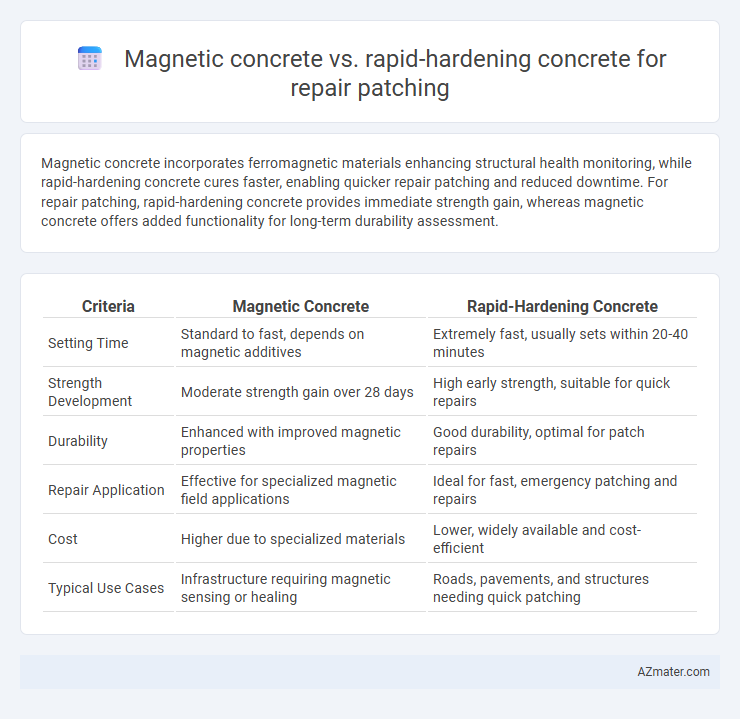Magnetic concrete incorporates ferromagnetic materials enhancing structural health monitoring, while rapid-hardening concrete cures faster, enabling quicker repair patching and reduced downtime. For repair patching, rapid-hardening concrete provides immediate strength gain, whereas magnetic concrete offers added functionality for long-term durability assessment.
Table of Comparison
| Criteria | Magnetic Concrete | Rapid-Hardening Concrete |
|---|---|---|
| Setting Time | Standard to fast, depends on magnetic additives | Extremely fast, usually sets within 20-40 minutes |
| Strength Development | Moderate strength gain over 28 days | High early strength, suitable for quick repairs |
| Durability | Enhanced with improved magnetic properties | Good durability, optimal for patch repairs |
| Repair Application | Effective for specialized magnetic field applications | Ideal for fast, emergency patching and repairs |
| Cost | Higher due to specialized materials | Lower, widely available and cost-efficient |
| Typical Use Cases | Infrastructure requiring magnetic sensing or healing | Roads, pavements, and structures needing quick patching |
Introduction to Magnetic and Rapid-Hardening Concrete
Magnetic concrete incorporates ferromagnetic particles, enabling unique electromagnetic properties that enhance structural health monitoring and durability in repair patching applications. Rapid-hardening concrete achieves early strength gain through accelerated hydration, allowing quicker return-to-service and reduced downtime in repairs. Both materials offer specialized advantages: magnetic concrete improves long-term performance through embedded sensing capabilities, while rapid-hardening concrete optimizes repair efficiency with fast curing times.
Key Properties of Magnetic Concrete
Magnetic concrete exhibits enhanced self-sensing capabilities due to the integration of ferromagnetic particles, enabling real-time structural health monitoring that rapid-hardening concrete lacks. Its key properties include improved electrical conductivity, electromagnetic responsiveness, and the ability to detect stress and strain variations without additional sensors. These features make magnetic concrete particularly advantageous for repair patching in critical infrastructure where continuous monitoring and early damage detection are essential.
Characteristics of Rapid-Hardening Concrete
Rapid-hardening concrete features a high early strength gain due to its unique cement composition, enabling repair patching to be completed quickly and reducing downtime. Its accelerated setting time enhances resistance to freezing and thawing cycles, making it ideal for environments requiring rapid turnaround and durability. Compared to magnetic concrete, rapid-hardening concrete is favored in scenarios where time-critical repairs demand early load application and fast return to service.
Application Methods for Repair Patching
Magnetic concrete employs electromagnetic fields to enhance bonding strength and accelerate the curing process during repair patching, allowing precise placement and improved structural integration. Rapid-hardening concrete utilizes chemical accelerators to significantly reduce setting time, enabling faster load application and minimizing downtime in repair operations. Both methods require surface preparation and controlled mixing techniques tailored to ensure optimal adhesion and durability in patch repairs.
Adhesion and Bond Strength Comparison
Magnetic concrete exhibits enhanced adhesion properties due to its unique electromagnetic additives that improve the bond interface with existing structures, resulting in superior bond strength compared to rapid-hardening concrete. Rapid-hardening concrete achieves quick setting times but often sacrifices long-term bond durability, making it less effective for sustained patching performance. Studies indicate magnetic concrete can increase bond strength by up to 25%, optimizing repair patch longevity under dynamic loads.
Setting Time and Early Strength Development
Magnetic concrete offers a controlled setting time due to the inclusion of magnetic additives that enhance hydration, promoting quicker early strength development compared to traditional mixes. Rapid-hardening concrete achieves significantly faster setting times, typically within 20-40 minutes, enabling early load application and reduced downtime in repair patching. While rapid-hardening concrete excels in immediate strength gain, magnetic concrete provides a balanced approach with improved microstructural bonding, which can result in durable repairs with moderate setting time.
Durability and Longevity in Repairs
Magnetic concrete enhances repair patching durability through embedded iron particles that strengthen the matrix against cracking and environmental degradation. Rapid-hardening concrete offers faster setting times but may sacrifice long-term durability due to increased shrinkage and lower resistance to chemical attack. For repair longevity, magnetic concrete provides superior structural integrity and resilience in harsh conditions compared to rapid-hardening concrete.
Cost-Effectiveness and Material Availability
Magnetic concrete offers a niche solution with moderate cost-effectiveness due to its specialized materials and limited availability, making it less accessible for widespread repair patching. Rapid-hardening concrete provides superior cost-efficiency and broad material availability, enabling faster project completion and reducing labor expenses in repair applications. For large-scale or urgent repairs, rapid-hardening concrete remains the preferred choice due to its balance of affordability and immediate usability.
Suitability for Different Repair Scenarios
Magnetic concrete offers enhanced durability and crack resistance, making it ideal for structural repair patches in environments subject to electromagnetic interference or requiring self-sensing capabilities. Rapid-hardening concrete provides quick strength gain suitable for urgent repairs in roadways, bridges, and facilities where minimizing downtime is critical. Choosing between the two depends on repair scenario priorities: magnetic concrete excels in specialized, long-term monitoring applications, while rapid-hardening concrete is preferred for fast-track, load-bearing patching needs.
Conclusion: Choosing the Right Concrete for Repair Patching
Magnetic concrete offers enhanced durability and self-healing properties, making it ideal for long-term structural repairs subjected to dynamic loads and environmental stress. Rapid-hardening concrete provides accelerated setting times, enabling quick restoration and minimal downtime for urgent patching needs. Selecting the appropriate concrete depends on project priorities such as repair speed, durability requirements, and exposure conditions to ensure optimal performance and longevity.

Infographic: Magnetic concrete vs Rapid-hardening concrete for Repair patching
 azmater.com
azmater.com